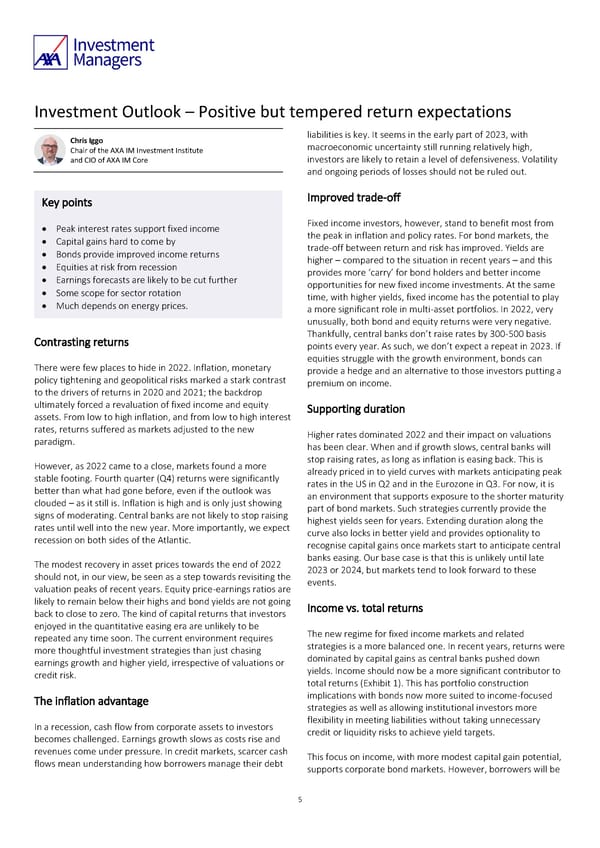Investment Outlook – Positive but tempered return expectations Chris Iggo liabilities is key. It seems in the early part of 2023, with Chair of the AXA IM Investment Institute macroeconomic uncertainty still running relatively high, and CIO of AXA IM Core investors are likely to retain a level of defensiveness. Volatility and ongoing periods of losses should not be ruled out. Key points Improved trade-off • Peak interest rates support fixed income Fixed income investors, however, stand to benefit most from • Capital gains hard to come by the peak in inflation and policy rates. For bond markets, the • Bonds provide improved income returns trade-off between return and risk has improved. Yields are • Equities at risk from recession higher – compared to the situation in recent years – and this • Earnings forecasts are likely to be cut further provides more ‘carry’ for bond holders and better income • Some scope for sector rotation opportunities for new fixed income investments. At the same • Much depends on energy prices. time, with higher yields, fixed income has the potential to play a more significant role in multi-asset portfolios. In 2022, very unusually, both bond and equity returns were very negative. Contrasting returns Thankfully, central banks don’t raise rates by 300-500 basis points every year. As such, we don’t expect a repeat in 2023. If equities struggle with the growth environment, bonds can There were few places to hide in 2022. Inflation, monetary provide a hedge and an alternative to those investors putting a policy tightening and geopolitical risks marked a stark contrast premium on income. to the drivers of returns in 2020 and 2021; the backdrop ultimately forced a revaluation of fixed income and equity Supporting duration assets. From low to high inflation, and from low to high interest rates, returns suffered as markets adjusted to the new Higher rates dominated 2022 and their impact on valuations paradigm. has been clear. When and if growth slows, central banks will stop raising rates, as long as inflation is easing back. This is However, as 2022 came to a close, markets found a more already priced in to yield curves with markets anticipating peak stable footing. Fourth quarter (Q4) returns were significantly rates in the US in Q2 and in the Eurozone in Q3. For now, it is better than what had gone before, even if the outlook was an environment that supports exposure to the shorter maturity clouded – as it still is. Inflation is high and is only just showing part of bond markets. Such strategies currently provide the signs of moderating. Central banks are not likely to stop raising highest yields seen for years. Extending duration along the rates until well into the new year. More importantly, we expect curve also locks in better yield and provides optionality to recession on both sides of the Atlantic. recognise capital gains once markets start to anticipate central banks easing. Our base case is that this is unlikely until late The modest recovery in asset prices towards the end of 2022 2023 or 2024, but markets tend to look forward to these should not, in our view, be seen as a step towards revisiting the events. valuation peaks of recent years. Equity price-earnings ratios are likely to remain below their highs and bond yields are not going Income vs. total returns back to close to zero. The kind of capital returns that investors enjoyed in the quantitative easing era are unlikely to be The new regime for fixed income markets and related repeated any time soon. The current environment requires strategies is a more balanced one. In recent years, returns were more thoughtful investment strategies than just chasing dominated by capital gains as central banks pushed down earnings growth and higher yield, irrespective of valuations or yields. Income should now be a more significant contributor to credit risk. total returns (Exhibit 1). This has portfolio construction implications with bonds now more suited to income-focused The inflation advantage strategies as well as allowing institutional investors more flexibility in meeting liabilities without taking unnecessary In a recession, cash flow from corporate assets to investors credit or liquidity risks to achieve yield targets. becomes challenged. Earnings growth slows as costs rise and revenues come under pressure. In credit markets, scarcer cash This focus on income, with more modest capital gain potential, flows mean understanding how borrowers manage their debt supports corporate bond markets. However, borrowers will be 5
 AXA IM Outlook 2023 full report Page 4 Page 6
AXA IM Outlook 2023 full report Page 4 Page 6